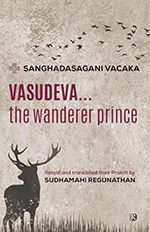This is a compendium of stories from Vasudevahindi, a text from the classical period written by Sanghadasagani Vacaka in Maharashtri Prakrit belonging to the Jaina tradition. It tells us primarily about the journeys of Vasudeva, who, with his dying breath had asked that he be reborn as the handsomest man in the world such that all women fall in love with him. Each of his journeys is an adventure and many of his journeys end with him acquiring a wife. We have encountered many of these adventures and love stories before, in texts such as Somadeva’s Kathasaritsagara. Even though Vasudevahindi sits firmly within the religious beliefs and practices of the Jainas, the stories are filled with love, desire, and the lure of wealth. They revel in the pleasures of cities and royal courts even as they include the bleaker landscapes of scrubby hills and difficult mountains, the rivers and forests where our protagonists must overcome both physical and spiritual challenges. Artha and kama are as much a part of our lives as the seduction of moksha, when we understand that the delights of the world are nothing but karmic bonds that keep us captive in a cycle of rebirth.
The mother lode of the great secular story traditions of northern India is the Sanskrit Brihatkatha, a lost text that is believed to have been put together close to the turn of the first millennium. Sanghadasa’s text follows the Brihatkatha in both form and content: the stories are framed within other stories within other stories within other stories, a compelling and complex narrative form that is believed to have originated in the Indian subcontinent among communities of itinerant monks and traders. The outermost frame of the Brihatkatha concerns the adventures of the Vidyadhara Prince Naravahanadatta, but Sanghadasa replaces the Vidyadhara with the monk/Prince Vasudeva who lives and breathes in a world of Jaina beliefs and values. As with other story texts from the classical period, this one too was probably compiled over centuries, picking one story from here and another from there. As it happens, Vasudeva, the hero of this Jaina narrative, is the father of Krishna of the Mahabharata.
It is precisely these elisions and slippages from one religious and cultural tradition to another that make the story texts so much fun to read. Part of the pleasure is recalling where you’ve heard the same story before, or recognizing what appears to be a unique incident as a trope. For example, I came across a lovely story in Vasudevahindi, in the ‘Adventures of Charudatta’ (a character who by his name and marriage to a courtesan named Vasantatilaka immediately calls to mind the wonderful play Mricchakatika by Shudraka, written around the same time), when our hero has become a trader and finds himself, at some point, instructed to kill and eat a goat. Unable to do this or bear the suffering of the animal that knows it is about to be killed, Charudatta sits with the goat and whispers Jaina precepts about karma and detachment, and prays as the goat surrenders to its death calmly. Charudatta is persuaded to climb into the goatskin and be carried off to safety across a raging river by a bird, just as Lohajangha (who also married a courtesan) climbs into an elephant skin and is carried to safety by a flood in the Kathasaritsagara.
Vasudevahindi also contains the story of the Ramayana, nestled in a chapter called ‘Madanavega Lamba’, narrated by someone called Dadhimukha who in the Valmiki Ramayana, is a minor monkey whose only role is telling Rama and Sugriva that the monkeys who are returning from the south must have been successful because drunk on honey, they have just destroyed the grove which was under his protection. The story of the Ramayana is basically as we would expect it to be, and because the Jaina text knows that we know the story already, Rama’s trials are told to us as if in precis—briefly and without embellishment. However, this version of Rama’s story is introduced with an incident where Ravana is told that the daughter he has with Mandodari will be the cause of his death. Ravana has the infant abandoned; she is rescued by Janaka as he ploughs his fields and she grows up to be Sita.
More than giving us the pleasure of floating in the sea of stories, texts such as Vasudevahindi remind us that classical India was not dominated by a single religion or ruled by a monolithic set of beliefs. On the contrary, the story texts portray a period that was diverse and plural, with many sects and creeds and religious practices and peoples who all lived variously and well. They knew the same stories; they told them in ways that they wanted to, shared ideas with confidence and impunity, and did not seem to care at all if their neighbours dressed, ate, drank, behaved or worshipped differently. Sudhamahi Regunathan’s light-handed translation presents us with a text in English that is easy, gentle in its persuasions, funny and with no intrusive fanfare. It provides a necessary alternate narrative of our shared past.
Arshia Sattar, translator and writer, has a Ph.D. in South Asian Languages and Civilizations from the University of Chicago, USA.

